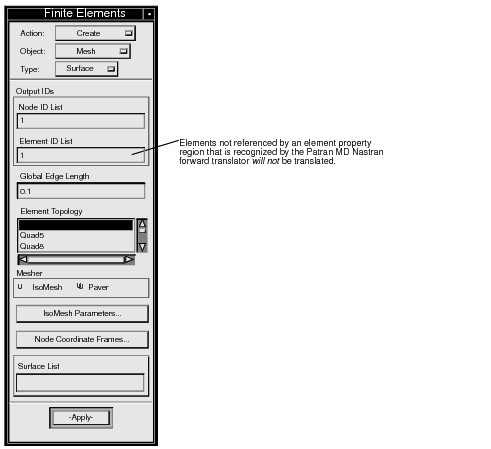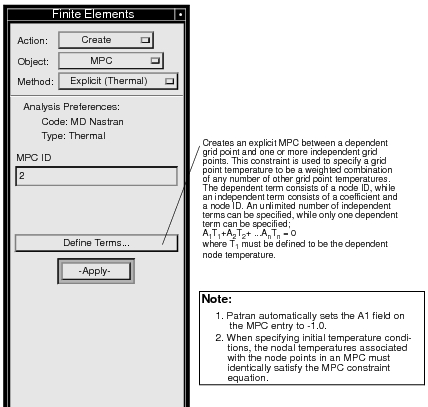XXXXXXXXXXXXXXXXXXXXXXXXXXXXXXXXXXXXXXXXXXXXXXXXXXXXXXXXXXXXXXXXXXXXXXXXXXXXXXXXXXXXXXXXXXXXXXXXXXXXXXXXXXXXXXXXXXXXXXXXXXXXXXXXXXXXXXXXXXXXXXXXXXXXXXXX''"> 3.2 Finite Elements
The Finite Elements Application in Patran provides options for creation of nodes, elements, and multi-point constraints in the thermal finite element model.
For more information on how to create finite element meshes, see
Mesh Seed and Mesh Forms (p. 25) in the Reference Manual - Part III. For information on the concepts of multi-point constraints, see the
Patran Thermal User’s Guide, Volume 1: Thermal/Hydraulic Analysis.
Nodes
Nodes in Patran will translate into unique GRID Bulk Data entries in MD Nastran. Nodes can be created either directly using the
Node object, or indirectly using the
Mesh object. Each node has associated Reference (CP) and Analysis (CD) coordinate frames. The ID is taken directly from the assigned node ID. The X1, X2, and X3 fields (Node Location List) are defined in the specified CP coordinate frame. If no reference frame is assigned, the global system is used. The PS and SEID fields on the translated GRID entry are left blank.

Finite Elements
The Finite Elements application in Patran assigns element connectivity, such as Quad/4 (CQUAD4), for standard finite elements. The type of MD Nastran element to be created is not determined until the element properties are assigned. See
the
Element Properties Form, 58 for details concerning the MD Nastran element types. Elements can be created either explicitly using the
Element object or implicitly using the
Mesh object.

Multi-Point Constraints
Multi-point constraints (MPCs) can also be created from the Finite Elements menu. These are special element types that define a rigorous algebraic relationship between several specified nodes. The forms for creating MPCs are found by selecting MPC as the Object on the Finite Elements form.
For MD Nastran thermal analysis, the MPC object is used to implement temperature coupling.





